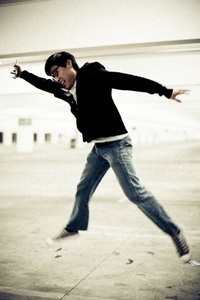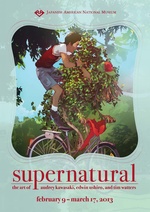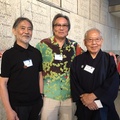“One girl cried,” says Edwin Ushiro, recalling an audience member’s reaction to his art. “She said it touched her.”
For Ushiro, art is about more than just creating beautiful images. It’s about telling stories with psychological impact. “If an image or thought pops into my head, I will mull over its historical significance and my emotional attachment to it,” he explains.
The Los Angeles-based painter, illustrator, and mixed media artist, whose work is highlighted in the Japanese American National Museum’s exhibition, Supernatural: The Art of Audrey Kawasaki, Edwin Ushiro, and Timothy Teruo Watters, finds inspiration in obake (Hawaiian ghost stories) and folk tales.
Originally from Maui, Ushiro attended “obake tours” during high school, led by the noted teacher, author, and historian Glen Grant.
“I learned that if you are interested enough, why not investigate a story?” says Ushiro. “My interest in the supernatural comes from living in Hawaii and having relatives in Japan. Both casually share ghost stories.”
“For example, out of nowhere the image of kids running through the night sky appeared as a vision,” Ushiro remembers. “I didn’t know what that meant. Then it came to me. My Grandma and Aunty once told me a story about a strange night when they heard loud footsteps on the roof. My Grandpa went outside to look who it was, but there was no one to be seen. He went inside the house and the footsteps continued.”
“Later they consulted a Hawaiian Minister who lived next door,” says Ushiro. “He told my relatives that this is the way the Hawaiians of the past will let you know that they were there first and that they are just letting you occupy that space. The Hawaiian minister added that they would not hear it again. And that was true.”
“I combined this story with the time I was having fun and pulling on this kid’s backpack strap and it broke,” says Ushiro. “The boy, Kalani, was so upset that he chased me across the campus until my friends stopped him. I suppose it was teenage angst. I really regret dong that. So it appears in my artwork and is hopefully released from my conscience.”
Ushiro embraces his cultural and family background and its influence on his work. “It’s in every idea, every line, every paint stroke I put down.”
“My mom was a fashion designer before she was a mother,” says Ushiro. “She says that I started to draw at age two. She taught me how to hold a pencil and showed me how to draw a spider. I followed her but didn’t enjoy the spider as a subject matter, so she asked me what I wanted to draw. I said a car. Then she showed me how to draw a car. Then, I started to draw different variations of cars that resembled the ones my relatives drove.”
After his parents encouraged his early creativity, Ushiro later found instructors and mentors who helped him find his path as an artist. “My ability to believe I can go further with my art is a gift I received from my high school art teacher, Janet Sato,” Ushiro says.
After high school, Ushiro moved to California to attend Art Center College of Design.
“I worked in the Alumni office while attending the College,” Ushiro says. “One of my assignments was to call and thank alumni who donated money for the student scholarship funds. It was just my night job, but turned into a networking situation after having such fun talking with those alumni: once I graduated, I had the opportunity to work with some of them. Most notably, I had the honor to be employed by Ron Padua, Art Director at Sony, and Ed Eyth, former Director of Creative Services at the Jim Henson Company.”
“My experience at Art Center was amazing!” says Ushiro. “Art Center encouraged you to find the not-so-obvious path. And so you start to develop your own unique way of seeing the world.”
“As a requirement, Illustration majors were forced to take several fine art courses,” Ushiro recalls. “In one of them, we viewed Hearts of Darkness: A Filmmaker’s Apocalypse. That film (about director Francis Ford Coppola and the making of his classic Apocalypse Now) made me realize how much higher I had to dream and how much harder I needed to work in order to accomplish those dreams.”
“Tony Zepeda, my printmaking instructor, showed me the dedication and respect an artist must have for ones craft,” says Ushiro. “I remember a colleague complaining about the toxicity of art materials. Tony’s response was, ‘Then don’t be an artist.’” Similarly, Ushiro says that his editorial illustration instructor, Jeff Smith, gave him hard criticism—but Ushiro welcomed it. “It changed the way I work.”
While still relatively young, Ushiro is now sharing his experience and insights with the next generation.
“For one day a week, I teach at the Otis College of Art and Design in Los Angeles and I tell my students to find the one thing that interests them and pursue that,” he notes. “Very often, artists are not encouraged to pursue their interests and end up following the safe path into obscurity.”
“It takes a lot of practice, but over time I have been able to produce artwork that closely resembles what I see in my head,” says Ushiro. “The characters are more expressive, and the themes carry a dual identity of meaning because I want them to also reflect what I am experiencing today.”
And in Ushiro’s present experience, it all comes back to his passion for other-worldly tales.
“I receive a lot of personal ghost stories, some first-person and some that have been passed on by family members,” Ushiro says. “Please let your readers know that I’d love to hear their accounts with the supernatural.” (He invites readers and fans to contact him through his website.)
“People feel welcome to share these stories with me because they won’t be ridiculed,” says Ushiro. “It’s kind of a sensitive and personal topic that I feel privileged to hear.”
* * * * *
Supernatural: The Art of Audrey Kawasaki, Edwin Ushiro, and Timothy Teruo Watters
February 9 – March 17, 2013
Japanese American National Museum
Los Angeles, California
Traditions are an integral part of every community. Some of these come from superstitions that our ancestors carried with them.
Supernatural features the work of Audrey Kawasaki, Edwin Ushiro, and Timothy Teruo Watters who have explored some of these otherworldly concepts, illustrating how traditional ideas have evolved and been adapted over time.
For more information about the exhibition >>
© 2013 Japanese American National Museum








